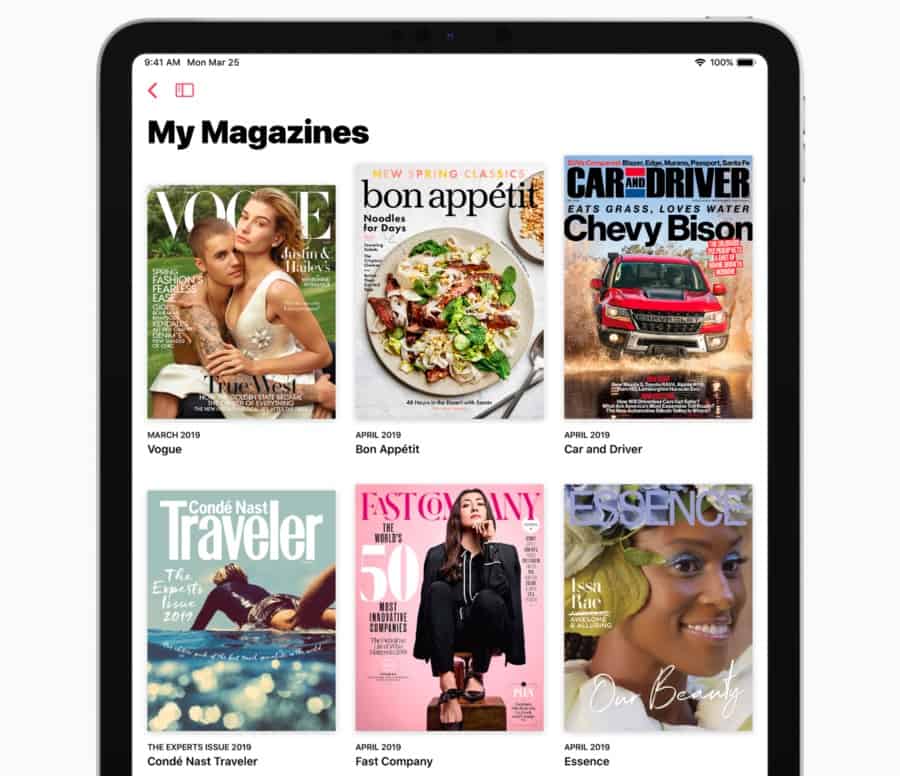
Above: A screen of magazines on the Apple News+ virtual newsstand. Photo courtesy Apple.
BitDepth#1194 for April 25, 2019
In March, Apple introduced a new subscription service, Apple News+, an upgrade to its earlier effort at bringing curated news to users of its devices.
The new version isn’t free. It’s a subscription service, offering at a cost of US$9.99, access to 300 magazines that would normally fill a newsstand.
If newsstands still existed in any significant way anymore. Which they don’t, because, well, digital.
Subscribers get access to quite a lot, including much of the Condé Nast stable, which includes Vogue, The New Yorker and Wired. The Los Angeles Times and the Wall Street Journal are also on board.
From Apple’s perspective, it’s riding in to save quality journalism and make it available to its users, a considerable potential audience.
Apple has more than a billion active devices in the market, and Apple News+ will push content on specially designed apps to all of them, including the Apple Watch.
It also launches with a hefty user base. The free version of Apple News had 60 million users in 2018 according to Comscore. Apple recently announced that those numbers had reached 85 million. Some might be tempted to start paying for their news.
In return, Apple wants half of the revenue that the publications generate.
But Apple hasn’t announced plans to follow its iTunes strategy and make Apple News+ a cross-platform revenue play, opening access to an estimated two billion Android devices and 700 million Windows devices.
That’s probably going to be a matter that demand decides. Apple won’t leave money on the table if it’s easy to access. The company has an Apple Music app on Google’s Play store.
That app has more than 10 million downloads and represents another revenue stream for the Cupertino company.
In response, Facebook has been talking about creating a dedicated News tab for its users, which would feature content it may pay to republish and offer it to its users for free.
Publishers are likely to be skittish about Facebook, whose entire approach to the news business has more in common with a flirty frontline masquerader than any long term commitment to partnering with news producers.
Facebook wooed publishers first with Instant Articles, which proved to be largely useless at driving traffic to publisher websites, and Facebook watch, which encouraged “pivots to video” that killed Mic.com and damaged other news producers after the social media company withdrew support and cash from the project.
What’s most surprising about this is that publishers still seem to think that the owners of popular digital ecosystems care about them at all.
The demolition of news distribution wrought by Google and Facebook and arguably made worse by their ‘helpful’ interventions should have sent a clear signal that we’re long overdue for a real solution for news distribution that’s built by journalists.
Most publishers and broadcasters are still producing traditional media, words on paper, broadcasts on television, and radios but can’t seem to draw line of evolution between the withering systems of distribution that supported news for most of the twentieth century and today’s fractured landscape, which is largely owned by social media platforms and search engines.
But those systems of distribution were owned by publishers and the understanding of what it meant to cede channels of distribution to third parties has been alarmingly slow in coming.
What’s needed now isn’t Apple News, Google News or Facebook News, it’s an equivalent and trusted platform for news distribution that’s owned and managed by publishers and broadcasters.
Digital publishers are still operating with the same presumptions that prevailed when they produced a product composed of atoms, the outdated notion they are competing with each other.
In Trinidad and Tobago and the wider Caribbean, creating such a distribution portal is more expensive per capita, but would address a smaller, more cohesive audience and its considerable diaspora which, despite the near total failure of Caricom to develop common ground for these islands, has more relevance to each other than to our first world neighbours.
Consider the possibilities of a Caribbean News web portal with robust search capabilities built into user profiles that curated modern linking techniques to online publications.
Digital publishers are still operating with the same presumptions that prevailed when they produced a product composed of atoms, the outdated notion they are competing with each other.
That is no longer true.
Publishers are competing against poor online attention spans, an unwillingness to read deeply, freely distributed information, the time and cost of verifying news, and the pervasive and destructive presence of fake news.
These are problems that are better solved through collaboration instead of petty competitiveness, but that’s still a limited resource in mass market publishing.
Will TechNewsTT be on Apple News? Oh yeah. That’s already underway for the same reason there’s a Google AMP version of site posts, links are regularly pushed to social media and Google News and my third effort at revamping an email newsletter is in development.
Publishers and broadcasters need readers and viewers first, but an effort, particularly locally, to partner on addressing the audience problem is long overdue.



